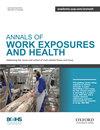281 Managing exposure to nanoparticles: Understanding the risk
IF 1.8
4区 医学
Q3 PUBLIC, ENVIRONMENTAL & OCCUPATIONAL HEALTH
引用次数: 0
Abstract
This session will outline the basic principles of nanoparticles. What is a nanoparticle? Learn the definitions and different vocabulary used in regulatory texts. How do they form? Naturally or manufactured, nanoparticles generation is either intentional or non-intentional and thus, difficult to spot. Where do we find them? Which industries are of concern? A lot of industries now are using nanomaterials intentionally for their physical and chemical properties, discover which ones and how you can get exposed to them within your processes. This CES will end with some insights on what are the health effects, biological interactions with the body and already known risks that has justified some legislations to put in place OELs for dedicated nanomaterials.281 管理纳米粒子暴露:了解风险
本节课将概述纳米粒子的基本原理。什么是纳米粒子?了解监管文本中使用的定义和不同词汇。它们是如何形成的?无论是自然形成还是人工制造,纳米粒子都是有意或无意产生的,因此很难发现。我们在哪里发现它们?哪些行业值得关注?目前,许多行业都在有意使用纳米材料,以获得其物理和化学特性,请了解哪些行业以及您在生产过程中如何接触到它们。在本次 CES 的最后,我们将深入探讨纳米材料对健康的影响、与人体的生物交互作用以及已知的风险,这些都是一些立法机构制定专用纳米材料 OEL 的理由。
本文章由计算机程序翻译,如有差异,请以英文原文为准。
求助全文
约1分钟内获得全文
求助全文
来源期刊

Annals Of Work Exposures and Health
Medicine-Public Health, Environmental and Occupational Health
CiteScore
4.60
自引率
19.20%
发文量
79
期刊介绍:
About the Journal
Annals of Work Exposures and Health is dedicated to presenting advances in exposure science supporting the recognition, quantification, and control of exposures at work, and epidemiological studies on their effects on human health and well-being. A key question we apply to submission is, "Is this paper going to help readers better understand, quantify, and control conditions at work that adversely or positively affect health and well-being?"
We are interested in high quality scientific research addressing:
the quantification of work exposures, including chemical, biological, physical, biomechanical, and psychosocial, and the elements of work organization giving rise to such exposures;
the relationship between these exposures and the acute and chronic health consequences for those exposed and their families and communities;
populations at special risk of work-related exposures including women, under-represented minorities, immigrants, and other vulnerable groups such as temporary, contingent and informal sector workers;
the effectiveness of interventions addressing exposure and risk including production technologies, work process engineering, and personal protective systems;
policies and management approaches to reduce risk and improve health and well-being among workers, their families or communities;
methodologies and mechanisms that underlie the quantification and/or control of exposure and risk.
There is heavy pressure on space in the journal, and the above interests mean that we do not usually publish papers that simply report local conditions without generalizable results. We are also unlikely to publish reports on human health and well-being without information on the work exposure characteristics giving rise to the effects. We particularly welcome contributions from scientists based in, or addressing conditions in, developing economies that fall within the above scope.
 求助内容:
求助内容: 应助结果提醒方式:
应助结果提醒方式:


